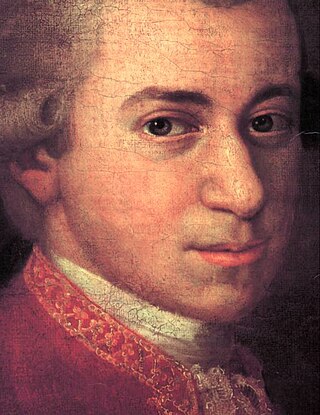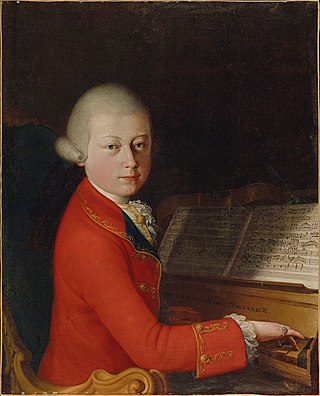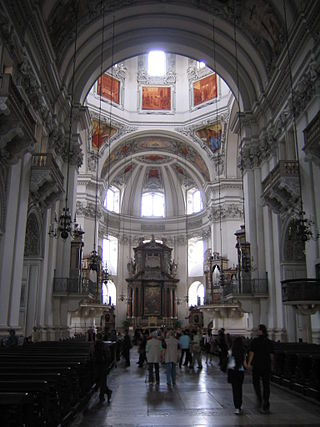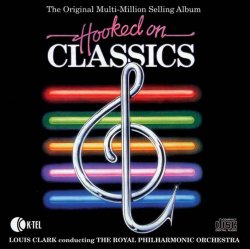
Eine kleine Nachtmusik, K. 525, is a 1787 composition for a chamber ensemble by Wolfgang Amadeus Mozart (1756–1791). The German title means "a little night music". The work is written for an ensemble of two violins, viola, cello and double bass, but is often performed by string orchestras. The serenade is one of Mozart's most famous works.

The Piano Concerto No. 17 in G major, KV. 453, by Wolfgang Amadeus Mozart, was written in 1784.

The Symphony No. 36 in C major, K. 425, also known as the Linz Symphony, was written by Wolfgang Amadeus Mozart during a stopover in the Austrian town of Linz on his and his wife's way back home to Vienna from Salzburg in late 1783. The entire symphony was written in four days to accommodate the local count's announcement, upon hearing of the Mozarts' arrival in Linz, of a concert. The première in Linz took place on 4 November 1783. The composition was also premièred in Vienna on 1 April 1784. The autograph score of the "Linz Symphony" was not preserved, but a set of parts sold by Mozart to the Fürstenberg court at Donaueschingen in 1786 does survive.

The Bassoon Concerto in B-flat major, K. 191/186e, is a bassoon concerto written in 1774 by Wolfgang Amadeus Mozart. It is the most often performed and studied piece in the entire bassoon repertory. Nearly all professional bassoonists will perform the piece at some stage in their career, and it is probably the most commonly requested piece in orchestral auditions – it is usually requested that the player perform excerpts from the concerto's first two movements in every audition.
The Sonata in A for Violin and Keyboard, K. 526, was written in Vienna in 1787 by Wolfgang Amadeus Mozart. It is placed in the Köchel catalogue between the string serenade Eine kleine Nachtmusik and the opera Don Giovanni.

Wolfgang Amadeus Mozart's Piano Concerto No. 12 in A major, K. 414 (385p), was written in the autumn of 1782 in Vienna. It is scored for solo piano, two oboes, two bassoons (optional), two horns, and strings. Like all three of the early Vienna concertos that Mozart wrote, it is a modest work that can be performed with only string quartet and keyboard. As per 18th century performance practice a string orchestra could also have served as a suitable option for the "quattro" accompaniment.

The Piano Concerto No. 27 in B♭ major, K. 595, is Wolfgang Amadeus Mozart's last piano concerto; it was first performed early in 1791, the year of his death.

The Piano Concerto No. 22 in E♭ major, K. 482, is a work for piano, or fortepiano, and orchestra by Wolfgang Amadeus Mozart, composed in December 1785.

The Sonata in C major, K. 19d, is a work for piano four-hands once thought to be composed by Wolfgang Amadeus Mozart in 1765 when he was nine years old in England. Composed in the traditional sonata form, it is one of the very few works thought to be written by Mozart for four-handed play.

The Piano Concerto No. 18 in B♭ major, KV. 456 is a piano concerto by Wolfgang Amadeus Mozart. In Mozart's own catalogue of his works, this concerto is dated 30 September 1784.

The Serenade No. 10 for winds in B-flat major, K. 361/370a, is a serenade by Wolfgang Amadeus Mozart scored for thirteen instruments: twelve winds and string bass. The piece was probably composed in 1781 or 1782 and is often known by the subtitle Gran Partita, though the title is a misspelling and not in Mozart's hand. It consists of seven movements.

The Piano Concerto No. 14 in E♭ major, K. 449, by Wolfgang Amadeus Mozart was written in 1784.

The Piano Concerto No. 15 in B♭ major, KV. 450 is a concertante work for piano and orchestra by Wolfgang Amadeus Mozart. The concerto is scored for solo piano, flute, two oboes, two bassoons, two horns, and strings.

Piano Concerto No. 5 in D major, K. 175, was composed by Wolfgang Amadeus Mozart in 1773, at the age of 17. It is Mozart's first original piano concerto; his previous efforts were based on works by other composers. In 1782, he revised the score and composed a new rondo, adding a flute to the instrumentation.

The Piano Concerto No. 8 in C major, K. 246, or Lützow Concert was written by Wolfgang Amadeus Mozart in April 1776 in the same year as the Haffner Serenade. Countess Antonia Lützow, 25 or 26 years old, second wife of Johann Nepomuk Gottfried Graf Lützow, the Commander of the Hohensalzburg Fortress, was a fine pianist. The solo work is not highly demanding, but it requires agility. Mozart played the concerto in Mannheim and Munich on October 4, 1777, and used it for teaching. Three different cadenzas have survived of varying difficulty, accommodating the abilities of performers from student level to professional: one for two pianos.

Great Pianists of the 20th Century – Géza Anda is volume one of the Great Pianists of the 20th Century box set, and it features music by the composers Béla Bartók, Frédéric Chopin, and Wolfgang Amadeus Mozart performed by the renowned pianist, Géza Anda.

Symphony No. 19 in E-flat major, K. 132, is a symphony composed by Wolfgang Amadeus Mozart in July 1772.
The six string quartets, K. 168–173, were composed by Wolfgang Amadeus Mozart in late 1773 in Vienna. These are popularly known as the Viennese Quartets. Mozart may have hoped to have them published at the time, but they were published only posthumously by Johann André in 1801 as Mozart's Op. 94.

The Credo Mass in C major, K. 257, is a mass composed by Wolfgang Amadeus Mozart in 1776. It is scored for SATB soloists, SATB choir, violin I and II, 2 oboes, 2 clarini, 3 trombones colla parte and basso continuo.

Hooked on Classics, produced by Jeff Jarratt and Don Reedman, is a multi-million selling album recorded by Louis Clark and the Royal Philharmonic Orchestra, published in 1981 by K-tel and distributed by RCA Records, part of the Hooked on Classics series.













